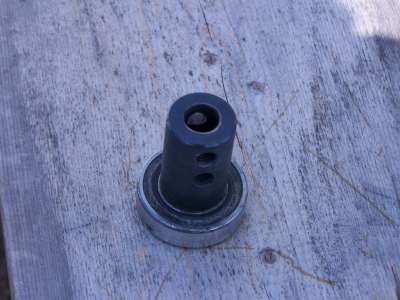Woodmonkey
Established Member
Anyone know where I can source a vacuum adaptor to fit a Nova lathe? The part is listed in the manual but a trawl of the net only brings up US sites, wondering if it's available anywhere in UK?
Cheers
Cheers









Woodmonkey":h27m7per said:What do those long numbers refer to, is there some sort of international standard for bearings?
Woodmonkey":18wk3hwo said:So just to clarify, the bearing mentioned in the link above should fit exactly into the recess in the handwheel of the lathe? It's just tight enough that it stays in by itself? Then I need a short length of pipe closed at one end, which will fit tightly inside the bearing, with one hole for the hose and one hole as a bypass? Doors it matter what the pipe is made of?
Cheers
bobham":2zowixlq said:The Nova hand wheel that was on my DVR had a threaded hole for a set screw to snug on to the outer race of the bearing and lock it in place. The outside diameter of the bearing was a very good slip fit into the hand wheel recess, but I wouldn't attempt to use it without the set screw. I have turned wooden pieces to fit the hand wheels of the lathes I have now and made recesses in them to fit the bearing. I have bored and tapped a hole in them to lock the bearing in place. Wood is not the best material to use for that because seasonal movement makes the hole tight at some times of the year and a bit sloppy at other times, but it is what I had available at the time. If I run across some kind of plastic in large enough section I might change it out.
There are actually three holes in the side of the pipe stub; two on one side and one on the other. I have no idea what the third hole is for. I use the two adjacent holes for my retaining bolt and bypass air flow.
Take care
Bob

Bill Mooney":27nz8505 said:Have a word with Simon Hope who should be able to help.
![IMG_20140506_125913[1].jpg IMG_20140506_125913[1].jpg](https://cdn.imagearchive.com/ukworkshop/data/attach/19/19219-IMG-20140506-125913-1-.jpg)
![IMG_20140506_154618[1].jpg IMG_20140506_154618[1].jpg](https://cdn.imagearchive.com/ukworkshop/data/attach/19/19221-IMG-20140506-154618-1-.jpg)
![IMG_20140506_134338[1].jpg IMG_20140506_134338[1].jpg](https://cdn.imagearchive.com/ukworkshop/data/attach/19/19222-IMG-20140506-134338-1-.jpg)
![IMG_20140506_153639[1].jpg IMG_20140506_153639[1].jpg](https://cdn.imagearchive.com/ukworkshop/data/attach/19/19224-IMG-20140506-153639-1-.jpg)
![IMG_20140506_142817[1].jpg IMG_20140506_142817[1].jpg](https://cdn.imagearchive.com/ukworkshop/data/attach/19/19223-IMG-20140506-142817-1-.jpg)
![IMG_20140506_161300[1].jpg IMG_20140506_161300[1].jpg](https://cdn.imagearchive.com/ukworkshop/data/attach/19/19225-IMG-20140506-161300-1-.jpg)
![IMG_20140506_161233[1].jpg IMG_20140506_161233[1].jpg](https://cdn.imagearchive.com/ukworkshop/data/attach/19/19226-IMG-20140506-161233-1-.jpg)
Enter your email address to join: